Launching a product is one of the most exciting yet nerve-wracking milestones in any business.
It's your chance to introduce your new offering to the world and make a lasting impression. But a successful product launch isn't just about having a great idea, it’s about how you bring it to market.
Without the right strategy, things can easily go off-track, and the excitement can quickly fade.
That's where a well-organized plan comes into play.
A product launch checklist helps you stay on top of everything, from pre-launch prep to post-launch follow-up, ensuring your team is all in sync, potential risks are tackled, and your product takes off smoothly.
Whether you're fine-tuning the last details or gearing up to celebrate a big launch, this guide has got you covered.
It walks you through each step of the process, helping you build momentum, generate buzz, and ultimately meet your business goals with a launch that truly shines.
So, let’s dive in, this checklist will give you the roadmap to ensure your product launch goes from a solid idea to a huge success.
What Is a Product Launch?
A product launch is the strategic process of introducing a new or updated product to the market.
It involves a coordinated effort across various departments such as product development, marketing, sales, and customer support to ensure the product is successfully introduced and adopted by the target audience.
The primary objectives of a product launch include generating awareness, creating anticipation, driving initial sales, and establishing a strong market presence.
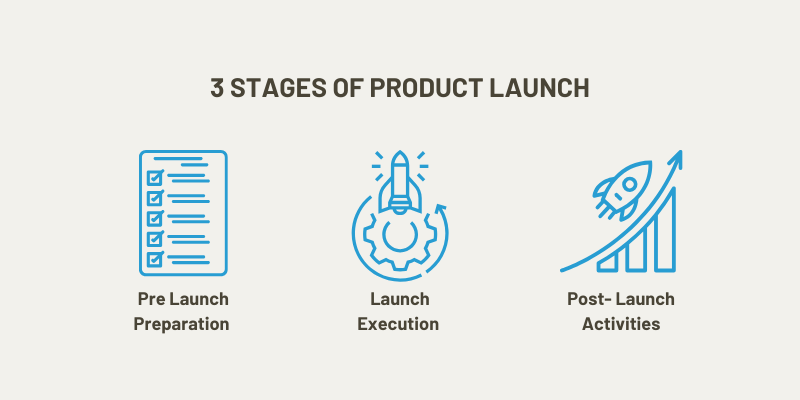
In today's digital world, companies also leverage performance marketing, digital marketing services, and social ads to amplify their launch efforts. To ensure digital strategies are optimized, many businesses partner with agencies like Centric, who help align marketing campaigns with the latest digital technologies and trends.
The launch process typically encompasses several stages:
- Pre-Launch Preparation: This phase involves market research, defining the target audience, developing a go-to-market strategy, and preparing marketing materials.
- Launch Execution: The product is officially introduced to the market through various channels, including advertising campaigns, public relations efforts, and promotional events.
- Post-Launch Activities: After the launch, it's crucial to monitor customer feedback, assess sales performance, and make necessary adjustments to the product or marketing strategies.
Explore Our Digital Marketing Services!
Product Launch Checklist: 16 Key Steps
A product launch checklist is a strategic tool that outlines all necessary tasks and activities to successfully introduce a new product to the market.
It ensures that teams are aligned, resources are allocated efficiently, and potential risks are mitigated.
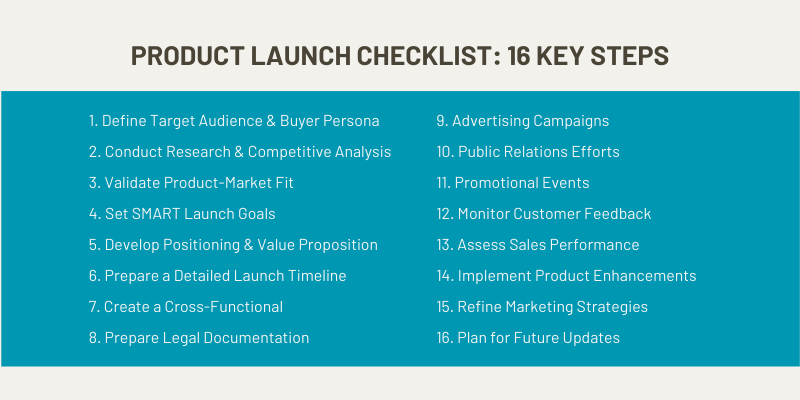
Here's a breakdown of essential steps to include:
Product Pre-Launch Checklist
The pre-launch phase is crucial for setting the foundation of a successful product introduction.
It involves strategic planning, market analysis, and team alignment to ensure that all aspects of the launch are well-coordinated and poised for success.
What are five marketing strategies that retailers spend half of their annual budget on? This is an important consideration during the planning phase, as choosing the right strategies will help maximize your launch’s potential.
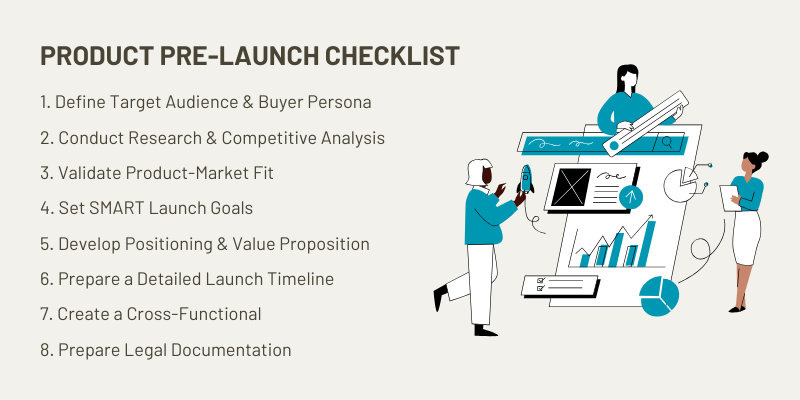
1. Define Target Audience and Buyer Persona
Begin by identifying who your ideal customers are. Segment your audience based on demographics, behaviors, and needs to create detailed buyer personas. This helps in tailoring marketing efforts and product offerings to meet the specific demands of each segment.
2. Conduct Market Research and Competitive Analysis
Gather data on industry trends, customer preferences, and competitor strategies. Understanding the market landscape allows you to identify opportunities, anticipate challenges, and position your product effectively.
Tracking Google keyword ranking can be helpful for gauging competitor visibility in search results.
3. Validate Product-Market Fit
Ensure that your product addresses a genuine market need and resonates with your target audience. This can be achieved through surveys, focus groups, or beta testing, providing insights into product acceptance and potential improvements. Testing for product-market fit is akin to how inbound marketing strategies track users across the web to refine their approach.
4. Set SMART Launch Goals
Establish Specific, Measurable, Achievable, Relevant, and Time-bound objectives for your launch. These goals could include targets for sales, customer acquisition, or brand awareness, providing clear benchmarks for success.
5. Develop a Positioning Statement and Value Proposition
Craft a concise statement that defines how your product meets the needs of your target audience uniquely and effectively.Highlight the benefits and differentiators that set your product apart from competitors, which can be emphasized through digital marketing services and advertisements. Highlight the benefits and differentiators that set your product apart from competitors.
6. Prepare a Detailed Launch Timeline and Roadmap
Create a comprehensive schedule outlining all pre-launch, launch, and post-launch activities. Assign responsibilities, set deadlines, and ensure that all teams are aligned with the timeline to maintain a smooth workflow.
7. Assemble a Cross-Functional Launch Team with Clear Roles
Bring together members from various departments marketing, sales, product development, customer support to form a cohesive team. Clearly define each member's role and responsibilities to ensure efficient collaboration and execution.
8. Prepare Legal/Compliance Documentation
Ensure that all necessary legal and regulatory requirements are met. This includes reviewing contracts, intellectual property rights, and compliance with industry standards to mitigate potential risks.
Explore Our Performance Marketing Services!
Product Launch Execution Checklist
The launch execution phase is where meticulous planning transforms into tangible market presence.
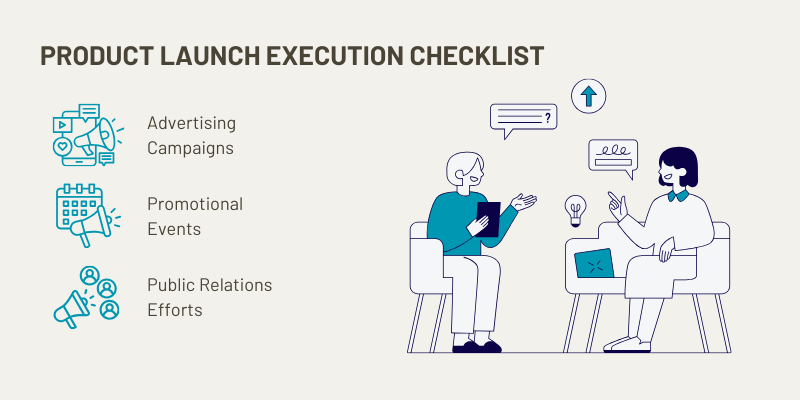
This stage involves a synchronized effort across various channels to introduce your product to the audience effectively.
What is the digital marketing strategy that tracks users across the web? Leveraging this strategy, like remarketing, can help retarget potential customers and improve your campaign's efficiency.
9. Advertising Campaigns
Strategic advertising is pivotal in reaching your target audience and generating buzz. Utilize a mix of digital platforms such as Google Ads, Facebook, Instagram, and LinkedIn to create targeted campaigns.
Craft compelling ad copy and visuals that highlight your product's unique value proposition. Implement A/B testing to optimize ad performance and ensure maximum engagement.
10. Public Relations Efforts
Public relations play a crucial role in building credibility and trust. Develop a comprehensive PR strategy that includes press releases, media outreach, and influencer partnerships.
Aim to secure coverage in reputable industry publications and blogs to enhance visibility. Leverage relationships with journalists and influencers to amplify your message and reach a broader audience.
11. Promotional Events
Hosting promotional events can create memorable experiences for your audience. Consider organizing in-person, virtual, or hybrid events to showcase your product.
Incorporate interactive elements such as live demonstrations, Q&A sessions, and giveaways to engage attendees.
Collaborate with industry experts or influencers to add credibility and attract a larger crowd. Ensure the event aligns with your brand's values and objectives to leave a lasting impression.
Product Post-Launch Checklist
The post-launch phase is important for assessing how well your product meets market expectations and identifying areas for enhancement.
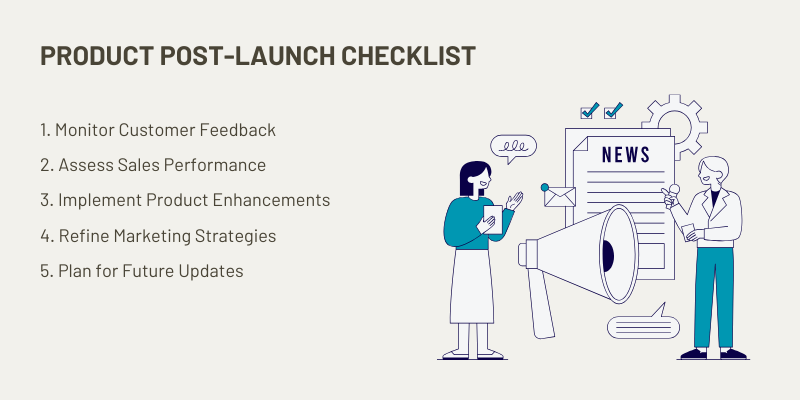
This stage involves systematically collecting and analyzing customer feedback, evaluating sales performance, and making data-driven adjustments to the product and marketing strategies.
12. Monitor Customer Feedback
Engaging with customers after the launch provides valuable insights into their experiences and satisfaction levels.
Utilize various channels such as surveys, social media, and customer support interactions to gather feedback.
Analyzing inbound vs outbound marketing strategies can also help determine how effectively you are reaching customers.
Key metrics to focus on include:
- Net Promoter Score (NPS): Measures customer loyalty and the likelihood of recommending your product.
- Customer Satisfaction Score (CSAT): Assesses overall satisfaction with the product.
- Customer Effort Score (CES): Evaluates the ease of using your product.
Regularly analyzing this feedback helps in identifying recurring issues, understanding customer needs, and prioritizing improvements.
allconsultingfirms.com
13. Assess Sales Performance
Tracking sales data post-launch is essential to gauge the product's market acceptance. Monitor metrics such as:
- Sales Volume: Total units sold over a specific period.
- Revenue: Total income generated from sales.
- Customer Acquisition Cost (CAC): The cost associated with acquiring a new customer.
- Customer Lifetime Value (CLV): The total revenue expected from a customer over their relationship with your brand.
Analyzing these metrics helps in understanding the financial success of the product and informs decisions on pricing, marketing spend, and sales strategies.
14. Implement Product Enhancements
Based on the collected feedback and performance data, prioritize areas for product improvement.
This may involve:
- Bug Fixes: Addressing technical issues reported by users.
- Feature Enhancements: Improving existing features or adding new ones based on customer requests.
- Usability Improvements: Making the product more user-friendly.
Adopting an iterative development approach allows for continuous product refinement, ensuring it evolves to meet customer expectations.
15. Refine Marketing Strategies
Evaluate the effectiveness of your marketing campaigns by analyzing:
- Conversion Rates: The percentage of leads that become paying customers.
- Customer Acquisition Channels: Identifying which marketing channels are most effective.
- Return on Investment (ROI): Assessing the profitability of marketing efforts.
Use these insights to optimize marketing strategies, allocate resources efficiently, and tailor messaging to better resonate with the target audience.
RevPartners
16. Plan for Future Updates
The post-launch phase is an opportunity to plan for the product's long-term success.
Consider:
- Roadmap Development: Creating a timeline for future product updates and features.
- Market Expansion: Exploring new markets or customer segments.
- Partnership Opportunities: Identifying potential collaborations to enhance product offerings.
Strategic planning during this phase ensures sustained growth and adaptability in a dynamic market.
Conclusion: Navigating a Successful Product Launch
Embarking on a product launch is a pivotal moment for any business, requiring meticulous planning and execution.
To ensure success, it's essential to follow a structured approach encompassing several key stages.
Planning should consider the best website builders for small businesses and e-commerce marketing strategies. Keep in mind, the combination of inbound marketing and smart digital tools ensures that the product launch stays on track and meets both short-term and long-term goals.
A successful product launch involves three critical phases:
- This foundational stage includes conducting thorough market research, defining clear objectives, and aligning your team. It's crucial to understand your target audience, identify their needs, and ensure your product addresses those effectively.
- This phase focuses on introducing your product to the market through various channels. Coordinated marketing campaigns, public relations efforts, and promotional events are vital to generate excitement and attract customers.
- After the launch, it's important to monitor customer feedback, assess sales performance, and make necessary adjustments to the product or marketing strategies. This continuous evaluation helps in refining the product and enhancing customer satisfaction.
To help you stay on top of each phase, a product launch checklist is a valuable tool that ensures every important detail is covered and executed efficiently.
Final tips for a successful product launch include starting preparations well in advance, staying agile to adapt to real-time feedback, and maintaining open communication with your customers to foster loyalty and gather valuable insights.









